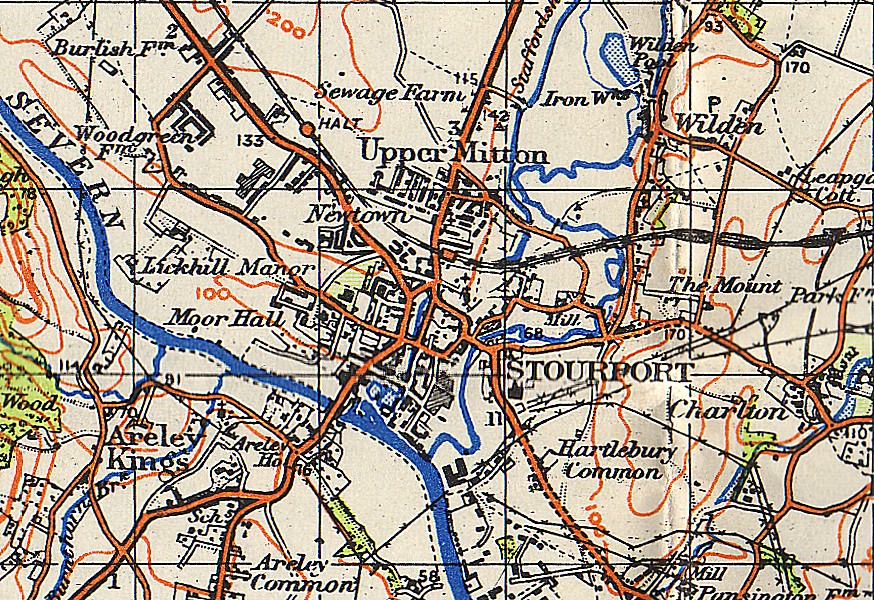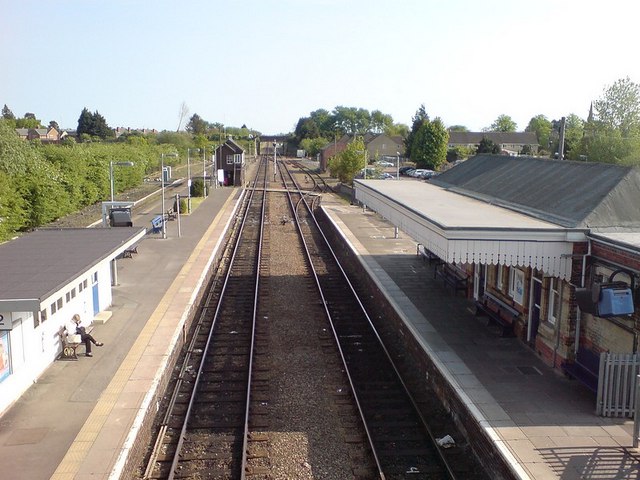|
Stourbridge And Kidderminster Bank
The Stourbridge and Kidderminster Bank was a bank that operated in England from 1834 until 1880 when it was taken over by the Birmingham Banking Company. History The bank was established in April 1834 by the industrialist James Foster with an office in High Street, Stourbridge. The building had been Foster's residence before his move to Stourton Castle. Originally called "Park House", it became known as "Bank House" after its conversion into offices. The first manager, John Amery and first cashier, Samuel Nock had living quarters in the bank building itself. Amery had been recruited from the Birmingham branch of the Bank of England. On formation, the bank had paid-up capital of £34,000. James Foster remained as chairman until 1850. In June 1834 a branch was opened at Kidderminster. In the same year it opened a branch in Bromsgrove and took over the business of Oldaker, Tomes and Chattaway in Stratford-on-Avon. The Bromsgrove branch was initially only open for 1 day per week, bu ... [...More Info...] [...Related Items...] OR: [Wikipedia] [Google] [Baidu] |
Banking
A bank is a financial institution that accepts deposits from the public and creates a demand deposit while simultaneously making loans. Lending activities can be directly performed by the bank or indirectly through capital markets. Because banks play an important role in financial stability and the economy of a country, most jurisdictions exercise a high degree of regulation over banks. Most countries have institutionalized a system known as fractional reserve banking, under which banks hold liquid assets equal to only a portion of their current liabilities. In addition to other regulations intended to ensure liquidity, banks are generally subject to minimum capital requirements based on an international set of capital standards, the Basel Accords. Banking in its modern sense evolved in the fourteenth century in the prosperous cities of Renaissance Italy but in many ways functioned as a continuation of ideas and concepts of credit and lending that had their roots in the a ... [...More Info...] [...Related Items...] OR: [Wikipedia] [Google] [Baidu] |
Kidderminster
Kidderminster is a large market and historic minster town and civil parish in Worcestershire, England, south-west of Birmingham and north of Worcester. Located north of the River Stour and east of the River Severn, in the 2011 census, it had a population of 55,530. The town is twinned with Husum, Germany. Situated in the far north of Worcestershire (and with its northern suburbs only 3 and 4 miles from the Staffordshire and Shropshire borders respectively), the town is the main administration centre for the wider Wyre Forest District, which includes the towns of Stourport-on-Severn and Bewdley, along with other outlying settlements. History The land around Kidderminster may have been first populated by the Husmerae, an Anglo-Saxon tribe first mentioned in the Ismere Diploma, a document in which Ethelbald of Mercia granted a "parcel of land of ten hides" to Cyneberht. This developed as the settlement of Stour-in-Usmere, which was later the subject of a territorial dispute ... [...More Info...] [...Related Items...] OR: [Wikipedia] [Google] [Baidu] |
Banks Established In 1834
A bank is a financial institution that accepts Deposit account, deposits from the public and creates a demand deposit while simultaneously making loans. Lending activities can be directly performed by the bank or indirectly through capital markets. Because banks play an important role in financial stability and the economy of a country, most jurisdictions exercise a Bank regulation, high degree of regulation over banks. Most countries have institutionalized a system known as fractional reserve banking, under which banks hold liquid assets equal to only a portion of their current liabilities. In addition to other regulations intended to ensure accounting liquidity, liquidity, banks are generally subject to minimum capital requirements based on an international set of capital standards, the Basel Accords. Banking in its modern sense evolved in the fourteenth century in the prosperous cities of Renaissance Italy but in many ways functioned as a continuation of ideas and concept ... [...More Info...] [...Related Items...] OR: [Wikipedia] [Google] [Baidu] |
Private Banks
Private banking is banking, investment and other financial services provided by banks and financial institutions primarily serving high-net-worth individuals (HNWIs)—defined as those with very high levels of income or sizable assets. A bank that specializes in private banking is called a private bank. Private banking is a more exclusive subset of wealth management, geared toward exceptionally affluent clients. The term "private" refers to customer service rendered on a more personal basis than in mass-market retail banking, usually provided via dedicated bank advisers. At least until recently, it largely consisted of banking services (deposit taking and payments), discretionary asset management, brokerage, limited tax advisory services and some basic concierge-type services, offered by a single designated relationship manager. History Private banking is how banking originated. The first banks in Venice were focused on managing personal finance for wealthy families. Priva ... [...More Info...] [...Related Items...] OR: [Wikipedia] [Google] [Baidu] |
Banks Of The United Kingdom
Central bank The Bank of England is the central bank of the United Kingdom. The Big Four British banking has been highly consolidated since the early 20th century. Unlike some other major economies, the UK does not have a major stratum of independent local banks. The number of independent banks shrank further during 2008: Northern Rock was nationalised by the UK Government (and is now owned by Virgin Money), followed by Bradford & Bingley; Alliance & Leicester was acquired by Santander, who merged it into Santander UK. On 18 September 2008, Lloyds TSB plc entered into a confirmed agreement to take over HBOS plc, which took effect on 19 January 2009, when HBOS was acquired and folded into Lloyds Banking Group. The retail and commercial banking markets are dominated by HSBC, Barclays, Lloyds Banking Group, NatWest Group and Spanish-owned Santander UK (most of these companies operate more than one banking brand in the UK). Banks incorporated in the UK A full list of busi ... [...More Info...] [...Related Items...] OR: [Wikipedia] [Google] [Baidu] |
Defunct Banks Of The United Kingdom
{{Disambiguation ...
Defunct (no longer in use or active) may refer to: * ''Defunct'' (video game), 2014 * Zombie process or defunct process, in Unix-like operating systems See also * * :Former entities * End-of-life product * Obsolescence Obsolescence is the state of being which occurs when an object, service, or practice is no longer maintained or required even though it may still be in good working order. It usually happens when something that is more efficient or less risky r ... [...More Info...] [...Related Items...] OR: [Wikipedia] [Google] [Baidu] |
Worcester, England
Worcester ( ) is a cathedral city in Worcestershire, England, of which it is the county town. It is south-west of Birmingham, north-west of London, north of Gloucester and north-east of Hereford. The population was 103,872 in the 2021 Census. The River Severn flanks the western side of the city centre. It is overlooked by Worcester Cathedral. Worcester is the home of Royal Worcester, Royal Worcester Porcelain, composer Edward Elgar, Lea & Perrins, makers of traditional Worcestershire sauce, the University of Worcester, and ''Berrow's Worcester Journal'', claimed as the world's oldest newspaper. The Battle of Worcester in 1651 was the final battle of the English Civil War, during which Oliver Cromwell's New Model Army defeated Charles II of England, King Charles II's Cavalier, Royalists. History Early history The trade route past Worcester, later part of the Roman roads in Britain, Roman Ryknild Street, dates from Neolithic times. It commanded a ford crossing over the Rive ... [...More Info...] [...Related Items...] OR: [Wikipedia] [Google] [Baidu] |
Stratford-upon-Avon
Stratford-upon-Avon (), commonly known as just Stratford, is a market town and civil parish in the Stratford-on-Avon district, in the county of Warwickshire, in the West Midlands region of England. It is situated on the River Avon, north-west of London, south-east of Birmingham and south-west of Warwick. The town is the southernmost point of the Arden area on the edge of the Cotswolds. In the 2021 census Stratford had a population of 30,495; an increase from 27,894 in the 2011 census and 22,338 in the 2001 Census. Stratford was originally inhabited by Britons before Anglo-Saxons and remained a village before the lord of the manor, John of Coutances, set out plans to develop it into a town in 1196. In that same year, Stratford was granted a charter from King Richard I to hold a weekly market in the town, giving it its status as a market town. As a result, Stratford experienced an increase in trade and commerce as well as urban expansion. Stratford is a popular touris ... [...More Info...] [...Related Items...] OR: [Wikipedia] [Google] [Baidu] |
Stourport
Stourport-on-Severn, often shortened to Stourport, is a town and civil parish in the Wyre Forest District of North Worcestershire, England, a few miles to the south of Kidderminster and downstream on the River Severn from Bewdley. At the 2011 census, it had a population of 20,292. History and early growth Stourport came into being around the canal basins at the Severn terminus of the Staffordshire and Worcestershire Canal, which was completed in 1768. In 1772 the junction between the Staffordshire and Worcestershire and the Birmingham Canal was completed and Stourport became one of the principal distributing centres for goods to and from the rest of the West Midlands. The canal terminus was built on meadowland to the south west of the hamlet of Lower Mitton. The terminus was first called Stourmouth and then Newport, with the final name of Stourport settled on by 1771. The population of Stourport rose from about 12 in the 1760s to 1300 in 1795. In 1771 John Wesley had called ... [...More Info...] [...Related Items...] OR: [Wikipedia] [Google] [Baidu] |
Shipston-on-Stour
Shipston-on-Stour is a town and civil parish in the Stratford-on-Avon District in Warwickshire, England. It is located on the banks of the River Stour, south-southeast of Stratford-upon-Avon, 10 miles (16 km) north-northwest of Chipping Norton, south of Warwick and 14.5 miles (23 km) west of Banbury. In the 2021 census, Shipston-on-Stour had a population of 5,849. This area is sometimes termed the Vale of Red Horse, close to the Oxfordshire and Gloucestershire borders.Beckinsale, R. (1980) ''The English Heartland'', Duckworth, p.5 History Etymology linked to sheep and wool trade In the 8th century, the toponym was ''Scepwaeisctune'', Old English for Sheep-wash-Town. It had a sheep marketplace for many centuries. The name evolved through ''Scepwestun'' in the 11th century, ''Sipestone'', ''Sepwestun'' and ''Schipton'' in the 13th century and ''Sepestonon-Sture'' in the 14th century. Church (vestry) administration, township and parish formation It was a township in the pa ... [...More Info...] [...Related Items...] OR: [Wikipedia] [Google] [Baidu] |
Redditch
Redditch is a town, and local government district, in north-east Worcestershire, England, approximately south of Birmingham. The district has a population of 85,000 as of 2019. In the 19th century, it became the international centre for the needle and fishing tackle industry. At one point, 90% of the world's needles were manufactured in the town and its neighbourhoods. In the 1960s, it became a model for modern new town planning. History The first recorded mention of Redditch (''Red-Ditch'', thought to be a reference to the red clay of the nearby River Arrow) is in 1348, the year of the outbreak of the Black Death. During the Middle Ages, it became a centre of needle-making and later prominent industries were fish-hooks, fishing tackle, motorcycles and springs, the last of which was notably undertaken by Herbert Terry and Sons. Redditch was designated a new town on 10 April 1964, and the population increased dramatically from 32,000 to around 77,000. Housing development ... [...More Info...] [...Related Items...] OR: [Wikipedia] [Google] [Baidu] |
Moreton-in-Marsh
Moreton-in-Marsh is a market town in the Evenlode Valley, within the Cotswolds district and Area of Outstanding Natural Beauty in Gloucestershire, England. The town stands at the crossroads of the Fosse Way Roman road (now the A429) and the A44. It is served by Moreton-in-Marsh railway station on the Cotswold Line. It is relatively flat and low-lying compared with the surrounding Cotswold Hills. The River Evenlode rises near Batsford, runs around the edge of Moreton and meanders towards Oxford, where it flows into the Thames just east of Eynsham. Just over east of Moreton, the Four shire stone marked the boundary of the historic counties of Gloucestershire, Warwickshire, Worcestershire and Oxfordshire, until the re-organisation of the county boundaries in 1931. Since then it marks the meeting place of Gloucestershire, Warwickshire and Oxfordshire. Toponymy Moreton is derived from Old English which means "Farmstead on the Moor" and "in Marsh" is from ''henne'' and ''m ... [...More Info...] [...Related Items...] OR: [Wikipedia] [Google] [Baidu] |

_Tower%2C_Castle_Road%2C_Kidderminster_(geograph_2328286).jpg)






